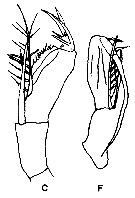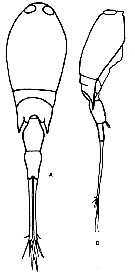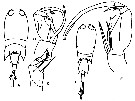|
|
 |
| Corycaeidae Dana, 1852 ( Cyclopoida ) * | | Ref.: | Claus, 1863 (part., p.83) ; Giesbrecht, 1892 (part., p.83); Esterly, 1905 (part., p.218); van Breemen, 1908 a (part., p.194 ; M. Dahl, 1912 (p.4, Rem.: S.G); Pesta, 1928 c (p.125); Sars, 1918 (p.194); Rose, 1929 (p.67); Oliveira, 1946 (p.474); Gonzalez & Bowman, 1965 (p.265); Owre & Foyo, 1967 (p.119); Chen, Zhang & Zhu, 1974 (p.52); Björnberg & al.,1981 (p.673); Bowman & Abele, 1982 (p.11); Razouls, 1982 (p.684); Zheng Zhong & al., 1984 (1989) (p.266, spp. Key); Sazhina, 1985 (p.94, N); Kang & al., 1990 (p.51, sub-genera and species keys); Huys & Boxshall, 1991 (p.284, 461); Razouls, 1993 (p.312); Chihara & Murano, 1997 (p.962); Bradford-Grieve & al., 1999 (p. 887, 973, Genera & S-Genera Key); Boxshall & Halsey, 2004 (p.16; 491: Def.; p.493: Genera and species keys; Rem. p.1: These authors are questionable concerning the order of Poecilostomatoida, and the validity of sub-genera); Vives & Shmeleva, 2010 (p.196, Rem., Genera key instead of Sub-genera) | | Rem.: | 2 G. (maintained provisionally before phylogenetic revision): Corycaeus, Farranula.
Wickstead (1962, p.547, 548, food & feeding).
Wi & al. (2013, p.415) underline many species of Corycaeidae are not adequately studied based on these detailed identification keys. This fact can cause erroneous identification when used in different areas, because sister and sibling species from different geographic regions may not be considered for their morphological variations or /and differences. | | * We thank Ruth Böttger-Schnack (Universität Bremen) for having forwarded to us a copy of the families Corycaeidae, Oncaeidae et Sapphirinidae from the Fauna of Japan by Chihara et Murano (1997), as well as the English translation concerning the Oncaeidae family performed by Hiroshi Itoh. |  Issued from : F. Vives & A.A. Shmeleva in Fauna Iberica, 2010, 33. [p.227, Fig.104]. After Dahl, 1912. As Farranula gracilis type species. Adult female: C, A2; D, P4. Adult male: F, A2. |
 Issued from : F. Vives & A.A. Shmeleva in Fauna Iberica, 2010, 33. [p.244, Fig.114]. After Dahl, 1912. As Urocorycaeus lautus type species. Female: A, habitus (dorsal). Male: D, habitus (lateral). |
 Issued from : F. Vives & A.A. Shmeleva in Fauna Iberica, 2010, 33. [p.213, Fig.95]. After Dahl, 1912; G.O. Sars, 1925. As Ditrichocorycaeus anglicus type species Female: A, habitus (dorsal); D, P4. Male: E, abdomen. |
 Issued from : F. Vives & A.A. Shmeleva in Fauna Iberica, 2010, 33. [p.237, Fig.110]. After Dahl, 1912. As Onychocorycaeus latus type species. Female: A, habitus (dorsal); B, A2; C, P4. Male: E, A2; F: habitus (dorsal). |
 Issued from : F. Vives & A.A. Shmeleva in Fauna Iberica, 2010, 33. [p.230, Fig.106]. After Dahl, 1912. As Monocorycaeus robustus type species. Female: A-B, habitus (dorsal and lateral, respectively); C, A2. Male: E, habitus (dorsal); F, A2. |
 Issued from : F. Vives & A.A. Shmeleva in Fauna Iberica, 2010, 33. [p.202, Fig.89]. After Giesbrecht, 1892; Cervigon, 1964. As Agetus typicus type species.. Female: A, habitus (dorsal); C, A2. Male: D, habitus (dorsal); E, P5; F, A2. |
 Issued from : F. Vives & A.A. Shmeleva in Fauna Iberica, 2010, 33. [p.207, Fig.92]. After Dahl, 1912; Cervigon, 1964. As Corycaeus speciosus type species. Female: A, habitus (dorsal); B, A2; C, P4. Male: D, habitus (dorsal); E, A2. |
 Issued from : Boxshall & Halsey in The Ray Society, 2004, Part II. [p.491] Armature formula of swimming legs P1 to P4. Inner seta on basis of P1 absent. Inner coxal seta absent in P3 and P4. P4 with 3-segmented exopod and endopod reduced to small knob bearing 1 or 2 setae. P1 to P4 with intercoxal sclerites. Exopods of P1 to P4 much larger than endopods. Setation of rami modified or further reduced in some genera. - P5 reduced to 2 setae on surface of somite. - P6 represented by genital opercula, armed with 1 long seta in male. - Egg sacs paired, multiseriate. | | | | | | Syn.: | Corycäus Dana, 1845; Giesbrecht, 1892 (p.85, 659); Agetus Kröyer, 1849 (in Damkaer & Damkaer, 1979, p.43); Giesbrecht, 1892 (p.659) | | Ref.: | Dahl, 1894 (p.67, spp. Key); Wheeler, 1901 (p.191); Esterly, 1905 (p.224); van Breemen, 1908 a (p.197, spp. Key); A. Scott, 1909 (p.245); Farran, 1911 a (p.282, 287); M. Dahl, 1912 (p.3, Rev., spp. Key); Sars, 1918 (p.194); Pesta, 1920 (p.645); Gurney, 1927 (p.160); Rose, 1929 (p.67); Wilson, 1932 a (p.354, spp Key.); Rose,1933 a (p.324, key of Sub-Genera); Mori; 1937 (1964) (p.130, spp. Key); Dakin & Colefax, 1940 (p.110, Key of Sub-Genera); Oliveira, 1946 (p.475); Sewell, 1947 (p.272, Rem.); Davis, 1949 (p.75); Carvalho, 1952 a (p.168); Motoda, 1963 (p.209, 213); Gonzalez & Bowman, 1965 (p.266); Owre & Foyo, 1967 (p.119, key of Sub-Genera, spp. Key); Chen, Zhang & Zhu, 1974 (p.52); Gibson & Grice, 1978 (p.66, Developmental stages, figs.); Kabata, 1979 (p.20); Björnberg & al., 1981 (p.675); Razouls, 1982 (p.684); Gardner & Szabo, 1982 (p.97); Zheng Zhong & al., 1984 (1989) (p.266, spp. Key, Rem.); Huys & Boxshall, 1991 (p.461); Razouls, 1993 (p.313); Chihara & Murano, 1997 (p.962); Bradford-Grieve & al., 1999 (p.973, clé spp.); Boxshall & Halsey, 2004 (p.491: Def.; p.493: spp. Key); Vives & Shmeleva, 2010 (p.197, 203, spp. Key) | | Rem.: | 6 S.G.: Agetus, Corycaeus, Ditrichocorycaeus, Monocorycaeus, Onychocorycaeus, Urocorycaeus. Boxshall (1998, p.221 & foll.) and Boxshall & Halsey, 2004 (p.491, 493) consider the sub-genera as genera awaiting an inevitable phylogenetic revision.
Total: 33 espèces + 2 unidentified. | | Remarks on dimensions and sex ratio: | | The mean female size is 1,297 mm (n= 33; S= 0,514; Cv= 0,396) and the mean male size is 1,143 mm (n= 31; S= 0,402; Cv= 0,352). The size ratio (M/F) is 0,878 ou 87,8 % (n= 31; S= 0,084; Cv= 0,096). | | | | | Agetus Kröyer, 1849 | | Ref.: | Kröyer, 1849 (in Damkaer & Damkaer, 1979, p.43); M. Dahl, 1912 (p.11, 30); Rose, 1933 a (p.325); Chihara & Murano, 1997 (p.964, Pl.211); Bradford-Grieve & al., 1999 (p.974: clé spp.); Boxshall & Halsey, 2004 (p.494); Vives & Shmeleva, 2010 (p.197, spp. Key) | | Rem.: | type: Corycaeus typicus. Total: 3 spp.
After Wi & al. (2013, p.415) the genus Agetus can be distinguished from other genera by the following morphological characteristics in both sexes, the body size is relatively larger (>1300 µm), in the female, the genital double-somite and the anal somite are fused an one somite, and in the male, the inner margin of the 1st endopodal segment of A2 is ornamented with spinules
The mean female size is 1.512 mm (n = 6; SD = 0.3028), and for male 1.412 (n = 6; SD = 0.2759). The size ratio male: female is 0.934. The sex ratio female: male is 1. | | | | Corycaeus Dana, 1845 | | Ref.: | M. Dahl, 1912 (p.12); Rose, 1933 a (p.325); Dakin & Colefax, 1940 (p.111, spp. Key); Sewell, 1947 (p.272, Rem.); Kang & al., 1990 (p.51, clé spp.); Chihara & Murano, 1997 (p.966, Pl.211); Bradford-Grieve & al., 1999 (p.974: spp. Key); Boxshall & Halsey, 2004 (p.493, spp. Key); Vives & Shmeleva, 2010 (p.197, 203, spp. Key) | | Rem.: | type: Corycaeus speciosus Dana,1849. Total: 4 spp. + 1 undet.
The mean female size is 1.763 mm (n = 8; SD = 0.3806), and for male 1.496 (n = 8; SD = 0.3962). The size ratio male: female is 0.849. The sex ratio female: male is 1.
| | | | Ditrichocorycaeus M. Dahl, 1912 | | Ref.: | M. Dahl, 1912 (p.11, 51); Rose, 1933 a (p.325); Dakin & Colefax, 1940 (p.113, spp. Key); Sewell, 1947 (p.278, Rem.); Tanaka, 1957 (p.85, Rem.); Vilela, 1968 (p.37, Rem.); Gonzalez & Bowman, 1965 (p.266); Bradford, 1978 (p.138); Kang & al., 1990 (p.52, spp. Key); Chihara & Murano, 1997 (p.963, Pl.210); Bradford-Grieve & al., 1999 (p.974: spp. Key); Boxshall & Halsey, 2004 (p.493, spp. Key); Vives & Shmeleva, 2010 (p.197, 208, spp. Key) | | Rem.: | type: Corycaeus (Ditrichocorycaeus) anglicus. Total: 15 spp. + 1 undet.
The mean female size is 0.954 mm (n = 30; SD = 0.2137), and for male 0.868 (n = 26; SD = 0.1749). The size ratio male: female is 0.91. The sex ratio female: male is nearest 1. | | | | Monocorycaeus M. Dahl, 1912 | | Ref.: | M. Dahl, 1912 (p.11, 27); Rose, 1933 a (p.325); Chihara & Murano, 1997 (p.962, Pl.211); Bradford-Grieve & al., 1999 (p.974); Boxshall & Halsey, 2004 (p.494,sp. Key); Vives & Shmeleva, 2010 (p.197, 229) | | Rem.: | Type: Corycaeus robustus Giesbrecht, 1891.. Total: 1 sp.
The mean female size is 2.200 mm, and for male 1.775 mm. The size ratio male: female is 0.81. The sex ratio female: male is 1. | | | | Onychocorycaeus M. Dahl, 1912 | | Ref.: | M. Dahl, 1912 (p.11, 82); Rose, 1933 a (p.325); Dakin & Colefax, 1940 (p.113, spp. Key); Sewell, 1947 (p.283); Kang & al., 1990 (p.53, spp. key); Chihara & Murano, 1997 (p.965, Pl.211); Bradford-Grieve & al., 1999 (p.974, 975: spp. Key); Boxshall & Halsey, 2004 (p.493, spp. Key); Vives & Shmeleva, 2010 (p.197, 231, spp. Key) | | Rem.: | type: Corycaeus latus Dana, 1849. Total: 7 spp.
The mean female size is 1.042 mm (n = 14; SD = 0.2881), and for male 0.914 (n = 14; SD = 0.2238). The size ratio male: female is 0.88 (n = 7; SD = 0.0838). The sex ratio female: male is 1. | | | | Urocorycaeus M. Dahl, 1912 | | Ref.: | M. Dahl, 1912 (p.10, 41); Rose, 1933 a (p.325); Dakin & Colefax, 1940 (p.111, spp. Key); Chihara & Murano, 1997 (p.962, Pl.210); Bradford-Grieve & al., 1999 (p.973, 975: spp. Key); Boxshall & Halsey, 2004 (p.493, spp. Key); Vives & Shmeleva, 2010 (p.197, 241, spp. Key) | | Rem.: | type: Corycaeus lautus Dana, 1849. Total: 3 spp.
The mean female size is 2.380 mm (n = 6; SD = 0.6217), and for male 1.898 (n = 6; SD = 0.6310). The size ratio male: female is 0.80 (n = 7; SD = 0.0838). The sex ratio female: male is 1. | | | | Corycella Farran, 1911 | | Ref.: | Farran, 1911 a (p.283); C. B. Wilson, 1950 (p.227, Rem.) | | Rem.: | Cf. Farranula | | | | (2) Farranula Wilson, 1932 | |
| | Syn.: | Corycella Farran, 1911 a (p.283); Wilson, 1932 (p.41, Rem.); 1932 a (p.361); Dakin & Colefax, 1940 (p.110, spp. key); Sewell, 1951 (p.385, Rem.); Kasturirangan, 1963 (p.79);
Corycaeus ( Corycella ) M. Dahl, 1912 (p.9, 106, spp. Key) | | Ref.: | Wilson, 1942 a (p.186: Rem.); 1950 (p.227); Motoda, 1963 (p.252); Gonzalez & Bowman, 1965 (p.267); Owre & Foyo, 1967 (p.119, spp. Key, Rem.); Vilela, 1968 (p.41); Corral Estrada, 1970; Razouls, 1982 (p.703); Kang & al., 1990 (p.54); Huys & Boxshall, 1991 (p.287); Razouls, 1993 (p.313); Chihara & Murano, 1997 (p.967, Pl.210); Bradford-Grieve & al., 1999 (p.888, 973, 975: spp. Key); Boxshall & Halsey, 2004 (p.493); Vives & Shmeleva, 2010 ( p.197, 223, Def., spp. Key); Wi & Soh, 2013 (p.21) | | Rem.: | Böttger-Schnack (1988, p.313, 315: tab.1, 2) consider this genus as a sub-genus of Corycaeus, but no (p.314, tab.3). In 1990 a and 1990 b the author maintains the sub-genus following the initial position of M. Dahl (1912).
Total: 8 spp. | | Remarks on dimensions and sex ratio: | | The mean female size is 0.863 mm (n = 16; SD = 0.1430), and the mean male size is 0.776 mm (n = 14; SD = 0.1241). The size ratio (Male: Female) is 0.912 (n= 7; SD = 0.0323). The sex-ratio is 1. | | | |
|
|
 Any use of this site for a publication will be mentioned with the following reference : Any use of this site for a publication will be mentioned with the following reference :
Razouls C., Desreumaux N., Kouwenberg J. and de Bovée F., 2005-2026. - Biodiversity of Marine Planktonic Copepods (morphology, geographical distribution and biological data). Sorbonne University, CNRS. Available at http://copepodes.obs-banyuls.fr/en [Accessed January 16, 2026] © copyright 2005-2026 Sorbonne University, CNRS
|
|
 |
 |










